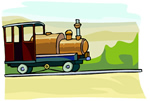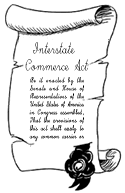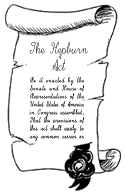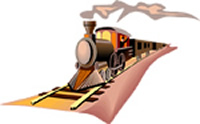

Between the Civil War and World War II, railroads were one of the nation’s most important businesses and an integral part of people’s lives. In this lesson, students assume the role of detectives investigating why the rail companies experienced a crisis in the 1960s and what helped the freight transport portion of the business return to profitability later in the same century. Students analyze a set of clues that help them explore the impact of government policies and changes in consumer demand on rail service. They discover that government policies (e.g., regulations, subsidies, and taxes) can have both positive and negative consequences in the marketplace. An interactive activity helps students understand that rail service competes in two different markets—passenger service and hauling freight. Students also learn that railroads and government policies have had to adjust as the transportation industry changed in the second half of the twentieth century.
Introduction
Get the students' attention by playing this sound clip of a train boarding call provided by the Pacific Southwest Railway Museum.
Ask students:
- How many of you have traveled on a train?

- Where did you go?
- Do you do this frequently?
- Why do you think very few people travel by train today? [Potential answers are the lack of availability of train routes, the convenience of automobiles, or the speed of airplanes.]
Tell students that from the Civil War to World War II, most people and goods in the United States traveled by rail. They are going to become detectives trying to find out why this is no longer true.
Just for fun, play this final boarding call provided by the Pacific Southwest Railway Museum .
Students are encouraged to use these web pages as they gather their clues.
Learning Objectives
- Summarize how government policies and changes in consumer demand contributed to a decline in the rail industry during the Twentieth Century.
- Identify factors that are helping the rail industry rebound.
- Give examples of how government policies have helped and hurt market participants, analyzing the implications for policymakers.
Resource List
- Pacific Southwest Railway Museum: This page provides a number of sound clips that can be used to gain student's attention during the lesson.
-
Passenger Trains: This page provides a historical summary of passenger trains.
americanhistory.si.edu/onthemove/themes/story_42_7.html
-
Railroad's Role: 1950-2000: This page provides information related to the changing role of railroads from 1950-2000.
americanhistory.si.edu/onthemove/themes/story_42_6.html
-
Markets Work Best When: This EconEdLink page provides information for students that explains what will help markets to work at their best.
Markets Work Best When
-
Assessment Rubrics: These rubrics should be used by the educator when evaluating student's performances during the RR lesson.
Rubrics
-
Brief Amtrak History: This page provides a brief summary of the history of Amtrak.
www.amtrakhistoricalsociety.org/bah.htm
-
A Brief History of High-Speed Rail Services: This TIME article provides a brief history of high speed railways.
http://content.time.com/time/nation/article/0,8599,1892463,00.html
- Interstate Commerce Commission: These pages help students complete their ICC assignment.
Process
 Have students work in teams of 2-4 students at computers reading the background information, doing the interactive activities, and completing their worksheets. Look at the process in the student version to see what they will be doing throughout this lesson.
Have students work in teams of 2-4 students at computers reading the background information, doing the interactive activities, and completing their worksheets. Look at the process in the student version to see what they will be doing throughout this lesson.
When students have completed their worksheets, get their attention by playing this short sound clip of a steam engine from the Pacific Southwest Railway Museum . Project the visual that identifies conditions when markets work best.
Discuss:
-
In your lesson, these conditions are identified as important to the efficient operation of markets. Using these criteria, explain why the federal government decided it had to regulate the rail industry.
[The market for rail service in many communities was not competive, they had only one or two rail lines. Some rail companies were in collusion, secretly setting prices. Railroads were also giving special discounts to favored shippers. Other shippers did not have access to this information which might have made it possible for them to negotiate lower prices for themselves.] -
How could this hurt buyers?
[Passengers and shippers were paying high prices, in some situations, they may have been subsidizing the shipments of the favored companies who were getting special discounts.] -
Do you think there might be occasions when a monopoly, one seller or a small number of sellers, would be an advantage for buyers?
[Providing rail service requires the laying of expensive rail lines. One rail company might be able to supply service at a lower cost than if two companies built two sets of tracks and divided service.] -
Can you think of any other industries that have been granted a monopoly for this reason?
[Electricity, telephone, natural gas, and cable have had monopolies in the past but just like the railroad industry, their industries are changing and competition is occurring through the delivery of service in new ways. Gas and electric utilities now share lines. Telephone and television have new modes of delivery, for example, wireless service and satellite service, respectively.]
Clues #1 & 3: Government policies such as business regulation often yield a combination of benefits and costs. 
-
What were the benefits of regulating the rail industry?
[Prices could no longer be artificially raised through secret agreements and small shippers no longer subsidized large shippers.] -
What was the negative impact of government regulation on the rail industry?
[Companies became less profitable and less able to compete. The supply in terms of the number of producers and rail lines declined, hence, the overall supply of rail service was reduced.] -
What was the cost to consumers?
[The number of rail routes avialable to consumers declined and the offering of high-speed rail service was curtailed.]
Clue #2: The Great Depression compounded the problems of the rail companies.
-
How was the supply of rail service affected?
[Companies became less profitable and less able to compete. The supply in terms of the number of producers and rail lines declined, the same problems identified in Clue #1.] -
How was the demand for rail service affected?
[A reduction in income led to a reduction in passenger travel. Cuts in production also reduced shipper demand for transporting goods.] -
We know that World War II was a good period for the rail industry. What helped the companies get turned around?
[Government use of the rails for military purposes encouraged expansion of supply and increased demand for rail service.]
Clue #4: By the end of World War II, the rail industry had several new competitors.
-
Who are these new competitors? The following Interactive Activity helps answer that question.
[Autos, busses, trucks, and airplanes.] -
What advantages do these competitors have over rail travel? This Interactive helps the students answer that question.
[Potential answers are: 1) Autos offer privacy and flexibility in terms of travel time. Autos and trucks can reach places where there are no rail lines. Airplanes are faster for long-distance travel than trains.]
 Clue #5: Federal support for auto and air travel is given as another reason why the rail industry had financial difficulties and was unable to remain competitive.
Clue #5: Federal support for auto and air travel is given as another reason why the rail industry had financial difficulties and was unable to remain competitive.
-
How did government subsidies hurt rail companies and help its competitors?
[The price of travel by auto, truck and plane did not reflect the full costs, building and maintaining highways, air terminals and other support infrastructure. There were also simply more highways and air routes offering consumers more route choices.] -
How do policies designed to keep fuel prices low favor competitors over the rail companies?
[Rail transport is more competitive when fuel prices are high.]
Conclusion
Ask a few students to share their one-sentence summaries of the reasons the rail industry experienced financial difficulties after World War II. If necessary, combine their responses to get a complete summary. [Two elements should be present in their responses: 1) Government policies made it difficult for the rail companies to profitably compete and 2) a change in consumer preferences shifted consumer demand to rail competitors.]
In this case study of the railroad industry, well-intentioned government policies yielded a variety of unintended negative  consequences.
consequences.
-
How was the rail industry hurt?
[Rail companies lost customers, profits and in some cases, went out of business.] -
How were consumers and shippers hurt?
[They had fewer transport choices. Someone might add that our remaining choices are dependent on fuel that is increasing in cost.] -
How is the environment hurt?
[Consumer and shippers often make choices that increase air pollution.]
What factors may help the railroads return to profitability?
[Any of the following answers are acceptable:
- Deregulation—such as the Staggers Act of 1980, freed freight railroads to operate like other businesses. Mobility of resources was restored and freight prices were able to adjust to reflect the actual cost of freight operation.
- Amtrak relieved the companies of money-losing passenger services.
- Intermodal containers made it easier and less costly to transfer goods between trucks, trains and ships, making use of rail for a portion of freight transport more appealing financially.
- Railroads are simply more efficient in terms of fuel, carrying 3 times more freight per gallon of fuel than big trucks and 80 times as much as planes.
- Railroads are also more efficient in terms of manpower, handling more than 7 times the amount of freight per truck employee and 21 times as much as plane employees.
- Capital investments in equipment and facilities required to expand rail transport capabilities are relatively minimal when compared to competitors, it is often just a matter of adding another rail car to the back of the train.]
This examination of the rail industry shows us that government policies can have both positive and negative consequences. What implication does this have for policymakers?
[Any and all of these responses are appropriate. Policy makers must:
- Policymakers must consider both the benefits and costs of regulation and government programs.
- It is not always possible to predict in advance the full consequences of government policies and programs.
- As circumstances change, there may be a need to change policies.]
Extension Activity
 Have students:
Have students:
- Debate whether the federal government should continue to use tax dollars to support passenger rail service, as it now does through Amtrak? In addition to the links already provided for this lesson, students are directed to this Wikipedia article on AMTRAK .
- Research high-speed rail service and determine what factors might make these trains successful in the U.S. Students are directed to this Wikipedia article as a source of information on High-Speed Rail Service .
- Identify the other industries the federal government later placed under the jurisdiction of the Interstate Commerce Commission and report on the present status of the ICC. Students are directed to these web sites to gather the information they need.
- Interstate Commerce Commission: These pages help students complete their ICC assignment.
- https://www.factmonster.com/encyclopedia/social-science/government/us/interstate-commerce-commission
- PBS
[Note to teachers: The Hepburn Act of 1906 brought bridges, terminals, storage facilities, oil pipelines, and ferries under ICC jurisdiction. The ICCs power was extended to radio, telephone and telegraph companies with the Mann-Elkins Act of 1910. In 1966, the ICC's safety functions were transferred to the Dept. of Transportation when that department was created. The ICC's powers over rates and routes in rails and trucking were curtailed in 1980 by the Staggers Rail Act and Motor Carriers Act. Most ICC control over interstate trucking was abandoned in 1994, and the agency was terminated at the end of 1995. Many of its remaining functions were transferred to the new National Surface Transportation Board.]
Assessment
Evaluation of student learning is based on completion of the worksheet and classroom discussion. If students work in groups to complete the worksheet, you may also want to assess their group participation. Three rubrics are provided to help you during the evaluation process. Weight and adjust them to meet your specific needs.
